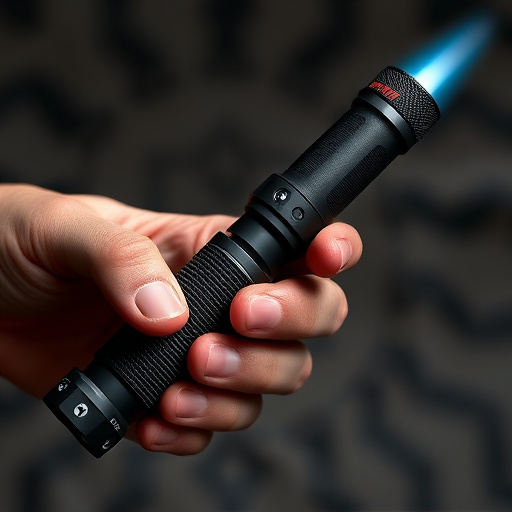Self-defense Expandable Batons are compact, versatile tools that offer easy carriage and powerful deterrence. Their unique expanding feature allows users to adapt to various attack scenarios by targeting sensitive zones like eyes, nose, throat, groin, and knees, maximizing impact and causing significant discomfort or permanent damage when struck correctly. Training involves mastering grip techniques, extension control, and retraction, practicing strikes on non-reactive targets, and progressing to controlled sparring with live partners under agreed rules. Effective baton use combines force, timing, and strategy in targeted areas like thighs, groin, and arms while maintaining safe distance and awareness of surroundings.
In today’s world, understanding self-defense tools like the self defense expandable baton is crucial for personal safety. This comprehensive guide delves into the art of using expandable batons effectively. We explore ‘strike zones’ and ‘target areas’, uncovering the science behind maximizing impact while ensuring safety. From identifying vital points to training tips, learn how to harness the power of this portable defense tool. Equip yourself with knowledge on self defense expandable baton techniques for enhanced protection.
- Understanding Self-Defense Expandable Batons: Tools for Protection
- The Science Behind Baton Strike Zones: Targeting Effective Points
- Identifying Vital Target Areas: Maximizing Impact and Safety
- Training Tips: Practicing Safe and Efficient Baton Strikes
Understanding Self-Defense Expandable Batons: Tools for Protection
Self-defense Expandable Batons are versatile tools designed for personal protection, offering a discreet yet powerful means of deterring potential threats. These innovative devices can be easily carried and quickly deployed when needed, making them an attractive option for individuals seeking effective self-defense solutions. The expandable nature allows users to adapt to various strike zones, providing a range of target areas to address different attacking scenarios.
Whether concealed in a pocket or purse or easily accessible on a belt, these batons offer convenience and peace of mind. Their design incorporates high-quality materials and robust construction, ensuring durability and reliable performance when required. With proper training, individuals can learn to utilize the baton’s reach and force effectively, enhancing their ability to protect themselves in unexpected situations.
The Science Behind Baton Strike Zones: Targeting Effective Points
The science behind baton strike zones involves understanding the human body’s vulnerabilities and the principles of force application. When using a self-defense expandable baton, targeting specific zones can maximize its effectiveness as a self-defense tool. Key areas include the eyes, nose, throat, groin, and knees—these points are sensitive and crucial for neutralizing an attacker quickly. The baton’s rigid structure allows users to deliver precise strikes that can incapacitate or turn the tide in a dangerous situation.
Research shows that focusing on these target areas can cause significant discomfort or even permanent damage if used correctly. For instance, striking the eyes can temporarily blind an assailant, while a well-placed knee strike to the groin can disable an attacker instantly. Mastering these techniques requires practice and understanding of body mechanics, but it ensures that users are equipped with powerful tools for self-defense in various scenarios.
Identifying Vital Target Areas: Maximizing Impact and Safety
Identifying the right target areas with a self-defense expandable baton is key to maximizing its impact and ensuring safety. When deployed, a baton should aim for pressure points on the body that, when struck, can incapacitate an aggressor temporarily. These zones typically include the groin, solar plexus, temple, jawline, and eyes. Each area has unique vulnerabilities; for instance, the groin is highly sensitive, while the solar plexus can disrupt balance and breathing.
By focusing on these specific target areas, users can achieve a swift response, allowing them to escape or gain help. Safety is paramount; proper training and understanding of legal implications are crucial when considering self-defense tools like an expandable baton. It’s important to note that while these techniques can be powerful, they should only be used as a last resort in situations where one’s safety is at immediate risk.
Training Tips: Practicing Safe and Efficient Baton Strikes
When training with a self-defense expandable baton, safety should always be the top priority. Start by mastering basic grip techniques and learning how to control the baton’s extension and retraction. Practice strikes against non-reactive targets like heavy bags or punching mats first. This allows you to focus on form and precision without worrying about impact. Gradually introduce live partners for controlled sparring, ensuring both parties understand the rules to prevent injuries.
Remember, effective baton strikes rely not just on force but also on timing and strategy. Train in various striking zones such as the thighs, groin, and arms, learning how to utilize the baton’s flexibility for maximum impact. Always maintain a safe distance and be mindful of your surroundings. Regularly review proper body positioning, hand placement, and follow-up techniques to ensure efficient and safe self-defense with your expandable baton.
In conclusion, understanding the science behind self-defense expandable batons, their strike zones, and target areas is key to maximizing their effectiveness while prioritizing safety. By mastering these techniques through proper training, individuals can confidently utilize this versatile tool for personal protection. Remember, a well-placed baton strike can be a game-changer in potentially dangerous situations, but it’s crucial to approach training responsibly and ethically.
